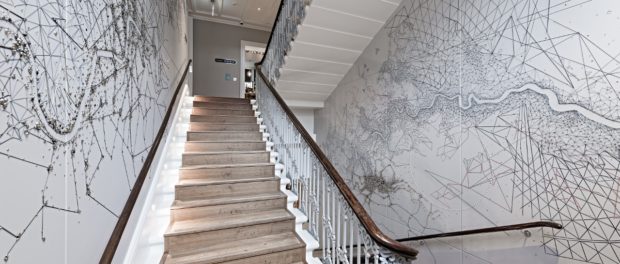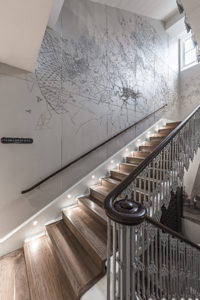Stunning new Debbie Smyth Art Installation now live at The Great Northern Hotel

‘A Tying of Knots’, a stunning new bespoke art installation by artist Debbie Smyth, which wraps around the staircase walls leading up to the restaurant, Plum and Spilt Milk, at The Great Northern Hotel in King’s Cross – the world’s first great railway hotel and now one of the finest luxury boutique hotels in London – is now complete.
The piece uses hammered nails and embroidery pins connected by threads to portray real places as strings of memory; a cartography of string that is both real and imagined, guiding hotel guests as they ascend the staircase. Debbie describes the piece as ‘a string of thoughts, a flight of stairs, a pencil of lines, a morning of hammers, a river of stories, a cluster of diamonds, a grid of maps, a twinkling of todays, an engagement of eyes, a journey of discoveries…’
The installation is the latest success in the close relationship between art consultants ARTIQ and the hotel’s Owner-Operator Jeremy Robson, involving the orchestration of spectacular and integrated art installations for the ground and first floor public spaces, as well as key stairwells, corridors and lift lobbies. The relationship has ensured that the hotel and its profound commitment to art has become a stand-out example of intelligent and inspired vision and curation.

Debbie Smyth’s ‘pin and thread’ work blurs the boundaries between fine art drawings and textile art and between illustration and embroidery
‘The programme, which is ongoing, includes several key elements, in addition to displays of carefully-selected and established individual British artists’, Patrick McCrae, Founder and MD of ARTIQ commented. ‘The first is a number of stand-out ‘signature pieces’, specially-commissioned or with a bespoke presentation, whilst the second is the creation of a mini-exhibition in each lift lobby, featuring an exciting emerging British artist and celebrating the network of links King’s Cross station has always made and continues to make with most of the British Isles. The final element links to The British Library as a major local cultural institution and features rotating exhibits from its great collection.’

The site-specific piece portrays a city in transition, referencing everything from Ordnance Survey maps to heat maps charting interaction in the internet age
‘A Tying of Knots’ is a site-specific sewn piece that portrays a city in transition; referencing everything from Ordnance Survey maps from bygone years and heat maps charting interaction in the age of the internet to the unspoken conversations and bumping bodies of strangers along the local waterways and winding streets, plus the hustle of intersections and stations.
As a textile artist, Debbie Smyth is most identifiable by her statement thread drawings: playful yet sophisticated contemporary artworks created by stretching a network of threads between accurately plotted pins. Her work beautifully blurs the boundaries between fine art drawings and textile art, flat and 3D work, illustration and embroidery, literally lifting the drawn line off the page in a series of “pin and thread” drawings.
As a fittingly poetic end to the project, the artist celebrated her own engagement whilst staying at The Great Northern Hotel – the transition to ‘tying the knot’ in her own life.
Jeremy Robson, Owner-Operator, Great Northern Hotel, commented: ‘Patrick McCrae of ARTIQ has an instinctive appreciation of how architecture, interior design and art must come together to play an influential part in generating a strong identity for a boutique hotel. He knows how an emotional connection must be created with our clientele. The Great Northern Hotel is a dignified icon that sits at the centre of the cultural and transportational crossroads that is King’s Cross St Pancras. The art curated by Patrick beautifully compliments the grace and timeless elegance of the hotel, whilst giving a playful nod to its origin amongst other Victorian industrial London landmarks – and being ever so slightly provocative, and so relevant to today.’

